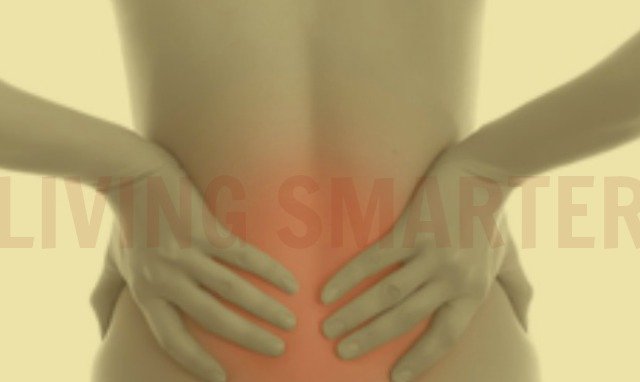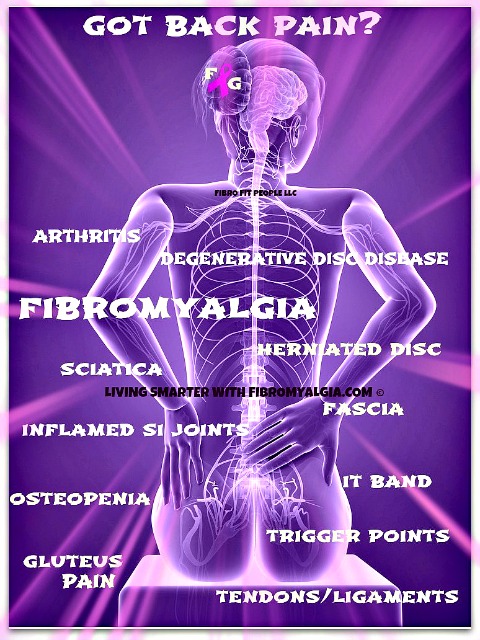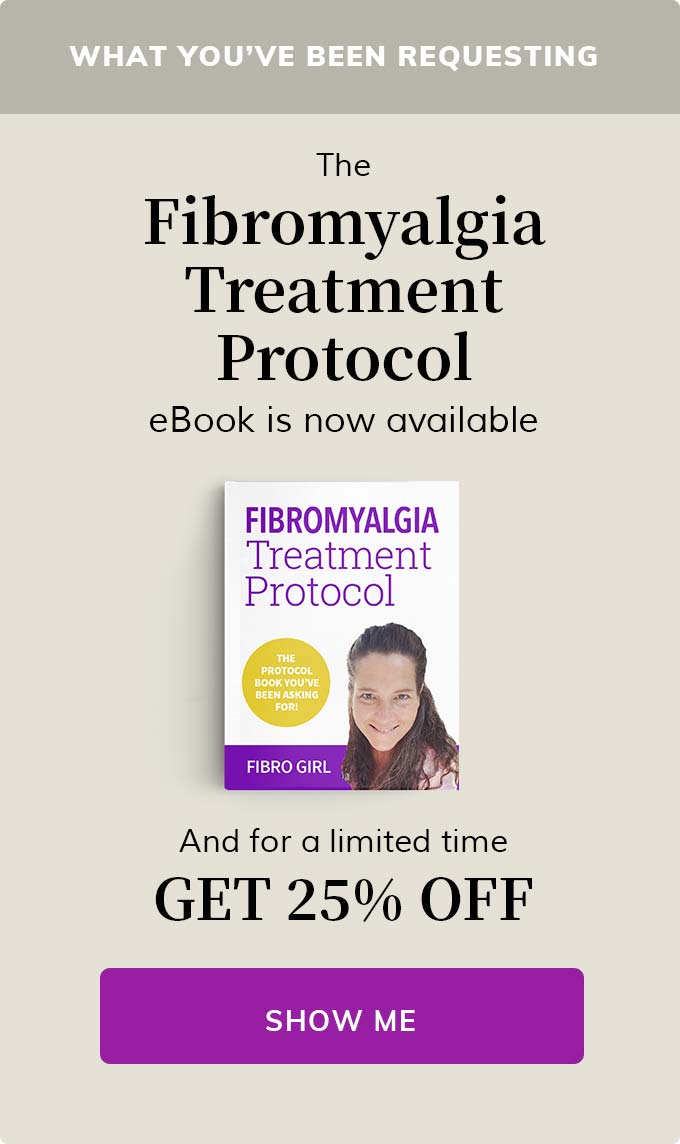Chronic Pain Management:
Lower Back Pain
 Fibromyalgia and lower back pain
Fibromyalgia and lower back painIf you have fibromyalgia, then you have likely experienced fibromyalgia related back pain. With many nerves and muscles in the back and around the spine, this is a vulnerable area for anyone but especially those with fibromyalgia and chronic pain issues.
Chronic
pain management techniques are often called for with every kind of back, spine and/or nerve related
pain.
In fact, because lower back pain is more common today, even in the non-fibro population, it’s no wonder that so many people are challenged with this often debilitating pain.
 Chronic Fibro Back Pain
Chronic Fibro Back PainWith
fibromyalgia, lower back pain is easily exacerbated mostly during activities of daily living. It could be improper sitting, sleeping, or bending the wrong way.
This can occur when trigger points are both present and/or active and radiate pain from the lower back into the SI joints, hip flexors, glutes and pelvic area.
The involvement with SI joints on the upper side on the buttocks also radiates pain to the lower back and even into the pelvic area. Sitting or standing for long periods of time can keep these areas tight and radiating.
For those with more severe fibro, even shorter periods of sitting can pose the same issue and should be limited, especially with a tendency toward inflammation within the SI joints of the lower back.
Elements of Chronic Pain
Management
Although
regular chiropractic adjustments can be helpful to keeping the fibro body in
better alignment, there are many perpetuating factors that need to be addressed
and other chronic pain management tools to be used consistently as well.
First, the fibromyalgia patient may have a more difficult time allowing the adjustment
to ‘hold’ like a non-fibro body …This can stem from the TRP’s that may be active
in the body OR due to ongoing tightness that we refer to in the article on
Myofascial Release (Treatment-For-Fibromyalgia-Myofascial-Release).
Second, any perpetuating factors such as lack of core strength and/or lack of agility need to be addressed with chronic pain management techniques.
Maintaining strength and agility will always be necessary
to avoid injury and stress on the more vulnerable areas of the body.
If you have Degenerative Disc Disease and Fibromyalgia, it is important to utilize the most effective but least invasive options to treating lower back pain.
And like fibro, it can feel progressive, however many experts on treating back pain believe that degenerative disc disease is more of a waxing and waning pain syndrome due to normal wear or aging and not really a "disease"
For more information on sciatica, refer to our article on sciatica pain.
With fibromyalgia, we are more "sensitive" to any kind of injections. If you choose treatments including injections such as epidurals, cortisone or even saline/cartilage injections, it is important to know that the fibro body will likely need more recovery time from the injection sites.
That is normal for a fibro patient. However, doctors treating other conditions in a fibromyalgia patient will not always know this.
Don't neglect the core
One of the more effective elements to decreasing lower back pain includes core
strength exercises, performed slowly and consistently. With chronic pain, it is often overlooked. This can be done in a variety
of ways, including in the standing position, with knee lifts and side bends that
activate the oblique muscles.
Hand weights are also optional with oblique work.
These type of exercises are great for people who cannot get down on the floor.
Again, strengthening the core in a safe and effective manner is essential for reducing
pain in the lower back and SI joints.
Lack of strength in the gluteal muscles can also affect pain in the lower back.
Weakness in the gluteus area can also exacerbate trigger points in the lower body. Core and glute strength support one another while supporting overall conditioning in the lower back region.
Another effective exercise is to lie on your back on a mat, and like you are building a bridge with your back, gently lift up from the lower back, put your hands under your back and just lift up and down and hold in the upper position 4-8 times. (See if you can go a little higher with each "bridging" session)
Decompression Techniques
Have you ever used de-compression techniques at your chiropractor’s office? This can be a very helpful component of chronic pain management for lower back pain.
The spine tends to get compressed through activities of daily living and by sitting and/or standing for extended periods of time so decompression is an effective tool.
We have also
found techniques utilizing inexpensive tools that can be used at home. One such tool is a small curved padded device that can aid in de-compression while
lying comfortably on the floor or even on a raised table.
Available here on this link, this device is called the Back Stretcher.
While utilizing any kind of de-compression, it is important to be very relaxed while 'allowing' the entire spine to release. It might not feel normal at first. Start with 1-2 minute increments and work up to 5-10 minutes per session.
What about the inversion table?
An inversion table can also be used for spinal de-compression either at home, at the gym or in the doctor's office.
Go slow when using inversion, especially with any active trigger points in the neck or back area. It has been found that even going just past 50% on the table can be helpful, so going slow and adjusting to the feeling of being inverted needs to be a consistent process.
I use an inversion table at home and my recommendation would be to get a good quality table if buying one for home or office use. I have also used them at the Chiropractors office and we now have one at the gym as well, so they are becoming more widely available.
I will provide another caution with inversion, but this won't be an issue until you are going past about 70% inversion.
If you have weakness in your ankles, you want to be sure to not only wear shoes while inverting, but also thick socks may be helpful and if you feel too much pressure on the ankles, then come back up as much as needed.
A few minutes per day is a good place to start. Again, even at just past 50%, you are taking pressure off the spine. Some people with fibromyalgia and CFS/ME might feel pressure in the head more quickly with inversion.
For instance, if you ever feel pressure in your head when leaning down, then this is a warning to go slow with increasing levels of inversion.
The "BeActive" Brace For Low Back Pain
- The patented pressure pad in the brace applies targeted pressure to the specifc point that provides back pain relief! BeActive is now FDA approved for Class 1 Medical Devices!
- Helps relieve lower back pain associated with Sciatica!
- Quick and easy to apply . The Beactive wrap should initially be worn for up to 2 hours at a time. If it remains comfortable, the wrap can be worn for longer periods as needed.
- Works on either right or left leg! The Beactive wrap fits the calf circumference sizes 12.5 inches to 18 inches measured around the fullest part of the calf. The Beactive wrap is effective when worn on a single leg on the side of the pain.
- Discreet and easily hidden under clothing.
Another
point of consideration and often a perpetuating factor in those with chronic
lower back pain is sitting too long first thing in the morning. Do you wake up
and sit in front of your computer or TV first thing in the morning?
For chronic pain management, it is
really essential to get the blood flowing around any painful areas of the fibro
body by following my "fitness protocol" (fibromyalgia-exercises) and taking a moderate walk before
engaging in other activities of daily living. Avoid prolonged sitting during
the first part of the day ..
You might also find my facebook fitness page, Fibro Fit People helpful in managing lower back chronic pain.
What About Posture?
When
we think of posture, we more often think about our upper body and our shoulders,
however the posture within our core and lower body is extremely important to pain management.
Do
you ever find yourself standing with one hip higher than the other, or unaware
of your spine?
How can we become better aware of our posture? Here is a simple move that we can
do anytime to remind ourselves of correct posture and improve body memory:
Draw up from the abdomen into the rib cage and hold.. so instead of merely putting
our shoulders back, we first draw up from the abdomen area while increasing the
range of motion within the entire back and spine.
This will also prevent us
from putting undue strain on the neck area. You will be surprised at how much pressure you can take off of the lower back when consistently practicing this drawing up from the lower back type of posture. (put a note at your computer/desk or wherever you sit for periods of time)
Other
perpetuating factors for back pain include sleeping positions and mattress
quality. Extra pillows around the sides of the body and under the knees can be
helpful.
Even a decrease in upper body strength can increase lower back pain when we attempt to lift something unusually heavy. We cannot afford the extra strain on the lower back due to over-compensation and/or ineffective posture.
Yes, overall body strength and agility in the fibro body is an essential part of chronic pain management and will always be important to
preventing injury and protecting the more vulnerable areas that are susceptible to pain.
Related articles:
Hip Flexor pain and fibromyalgia
A New Excellent Tool for Lower Back Pain Management
I've discovered a new tool for my constant lower back pain which is one of my most troublesome areas of chronic pain; its called the Lo-Bak Trax.
I've been using this for a few weeks and its helped a lot. I love it. Click on the links and wander on over to Amazon and check it out.
About the product: Lo-Bak Trax
- FDA Cleared to treat: Herniated Discs, Stenosis, Sciatica & Degeneration
- Easy, Comfortable and More Effective because you can Target Your Pain
- You are in TOTAL CONTROL of the amount and direction of the force applied
- Totally Portable, weighs less than 4 lb's and can fit in a suitcase
- Hand welded at 5 different points and comes with a lifetime guarantee against breakage
Back pain and Adrenal Health
Sometimes lower back pain or mid back pain can be due to adrenal stress. We cover many things related to adrenal health in this article.
Before you leave, my sitemap can provide you with a "God's-eye" view of this website laid out in "outline format".
Stay connected by joining our unique Email here at Fibro Repair Email
HOME > Fibromyalgia-Treatments > Chronic-Pain-Management-Lower-Back
Didn't find what you were looking for? Search for it:
living-smarter-with-fibromyalgia.com
©2013-2024 All Rights Reserved
FibroFitPeople, LLC ;©2024 All Rights Reserved









